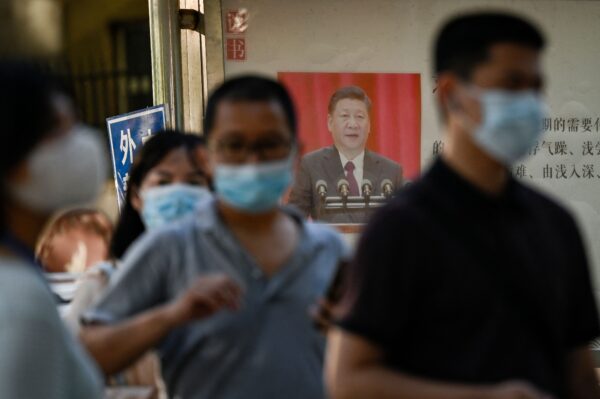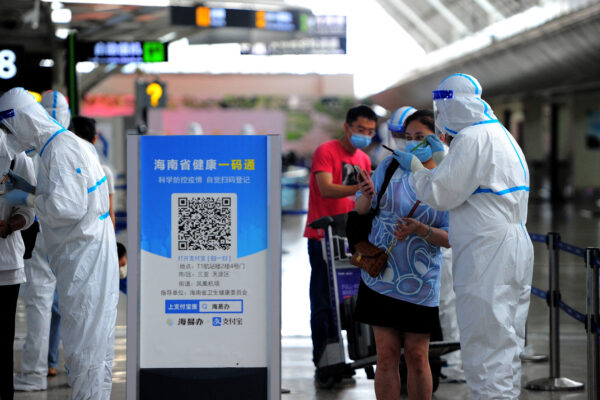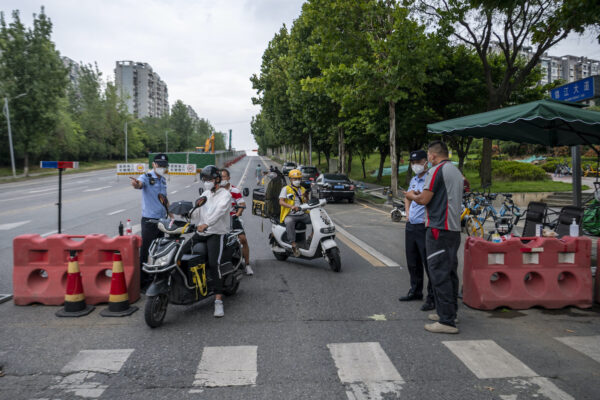
A young girl is given a nucleic acid test by a health worker at a makeshift COVID-19 testing site in Beijing, China, on April 29, 2022. (Kevin Frayer/Getty Images)
By
Schools postpone reopening. Businesses are shut down. Residents line up for a new throat swab.
Once again, dozens of Chinese cities are tightening COVID curbs in the run-up to the major Chinese Communist Party (CCP) meeting next month.
A weeklong lockdown in the metropolis of Chengdu was extended on Sept. 8 after over a hundred COVID-19 cases were reported. Officials on Sept. 1 ordered its 21 million residents to stay at home while conducting three-day citywide COVID-19 testing. The order had since been extended.
At Thursday’s briefing, authorities extended the curbs in most areas as “the risk of community transmission still exists in some regions.” Chengdu, the biggest city to be locked down since Shanghai’s two-month closure, has yet to announce an exit plan.
At least 34 Chinese cities have been placed under partial or full lockdown as of Sept. 5, including seven provincial capitals, according to the health news platform of People Daily, the CCP’s flagship newspaper. These cities range across the country, from northern oil production center Daqing city to southern tech hub Shenzhen.
The COVID curbs disrupt the lives of 291.7 million residents, accounting for 20.7 percent of China’s population, Japanese bank Nomura said in its Sept. 6 note. Nomura estimates that 49 Chinese cities had various levels of lockdowns or control measures, which contribute to 24.5 percent of the country’s gross domestic product (GDP).
The widespread shutdown came as the CCP prepares for its important 20th Party congress, which is set to open on Oct. 16 in Beijing. During the twice-a-decade party conclave, Chinese leader Xi Jinping is seeking a record-breaking third five-year term in office, and the new top leadership will be unveiled.
While Xi is expected to secure his position, “the rising infections have become the biggest variable of the party congress,” said Chinese commentator Wang He. “If the outbreak hit Beijing suddenly, could the party congress continue?”

People line up to be tested for COVID-19 next to a propaganda poster showing China’s leader Xi Jinping on a bulletin board in Beijing on Aug. 31, 2022. (Jade Gao/AFP via Getty Images)
Regular Tests and Travel Restrictions
Since September, 29 of the country’s 31 provinces have reported new infections, Mi Feng, the spokesperson of the national health commission, told reporters at Wednesday’s press conference.
Facing the challenges posed by the highly-contagious Omicron variant, Mi empathized officials must stick to the regime’s zero-COVID approach “unswervingly.” The stringent policy aims to eliminate any infection among communities through regular testing, mandatory quarantine, and repeated lockdown.
The official said cities reporting no new infections must implement a “normalized” testing system, implying that residents be tested every few days.
The move, which drew rebuke from Chinese social media users, marks a U-turn in policy. The national health commission said in a June press conference that checking COVID test results “shouldn’t become a new norm” in cities without outbreaks.

A tourist goes through pre-departure formalities at the Sanya Phoenix airport as stranded holidaymakers prepare to leave the COVID-hit resort city of Sanya on Hainan Island on Aug. 9, 2022. (STR/AFP via Getty Images)
Nevertheless, health authorities on Wednesday said residents who take trains, planes, long-distance buses, and ferries are required to show proof of a negative COVID test result from the previous 48 hours.
The new curbs will take effect through Oct. 31, covering the major Party gatherings and upcoming holidays.
Authorities urged residents to stay put during the Saturday–Monday Mid-Autumn Festival and the week-long holiday at the beginning of October.
In the capital city, travel restrictions have already been tightened earlier this week. People who have visited county-level administrative divisions with a single confirmed case in the given seven-day period are banned from entering Beijing, the city authorities’ spokesperson told a press briefing on Sept. 3.
Costs
The costs of sticking to the CCP’s zero-COVID strategy are mounting.
The lockdown of tens of millions earlier this year has slashed China’s economy, sending youth unemployment to a record high and prompting foreign companies to shift their investment out of the country. Seeing the latest lockdown, economists further slashed China’s economic growth forecast. Nomura on Tuesday cut the full-year GDP forecast to 2.7 percent from August’s 2.8 percent, far lower than Beijing’s target of “around 5.5 percent.”

Police officers check people’s information at a roadblock amid restrictions due to an outbreak of COVID-19 in Chengdu, southwestern Sichuan Province, China, on Sept. 1, 2022. (CNS/AFP via Getty Images)
Still, the seemingly endless lockdown has inflicted pain on residents. In Chengdu, viral videos on Chinese social media show people being barred from fleeing their homes in the aftermath of a 6.8 magnitude earthquake earlier this week.
A woman from Guiyang, a southwestern city where more than half of the city has been locked down since Sept. 5, said many are enduring food shortages in her communities. She lives in Huaguoyuan Community, home to roughly 400,000 residents.
“[The lockdown] was very abrupt, and many didn’t prepare supplies,” she told The Epoch Times on Sept. 8. “We’re in a quite tough situation.”
Control
Petitioners and dissidents, meanwhile, claim officials are using the COVID control measures to keep them out of the public eye so as to not disrupt the upcoming CCP congress.
Yang Jiahao, a man who was detained for over 400 days after writing and publishing a letter to the Chinese leader in protest of local authorities’ decision on his lawsuit, planned to travel to Beijing on Sept. 5 in the hope of seeking justice.
But the petition was forced to be canceled. He found that his code on the mandatory health surveillance app suddenly turned red in the morning. Yang said he tested negative on Sept. 4 before being summoned by local officials later that day. The red code means he lost access to everywhere, from public toilets to shops to train stations, and faced mandatory quarantine.
Yang told The Epoch Times on Sept. 8 that he is currently under home quarantine, though his second test on Thursday still returned with a negative result. He said officials sealed the door with paper and installed electronic alarms to enforce home quarantine, despite having little to no food left at home.
“They abused…epidemic prevention and control data, turning my health code red and [enforcing] home quarantine,” said Yang. “Their methods to maintain social stability are extremely evil.”
Luo Ya, Gu Xiaohua, Xiao Lvsheng, Li Xi, and Reuters contributed to the report.